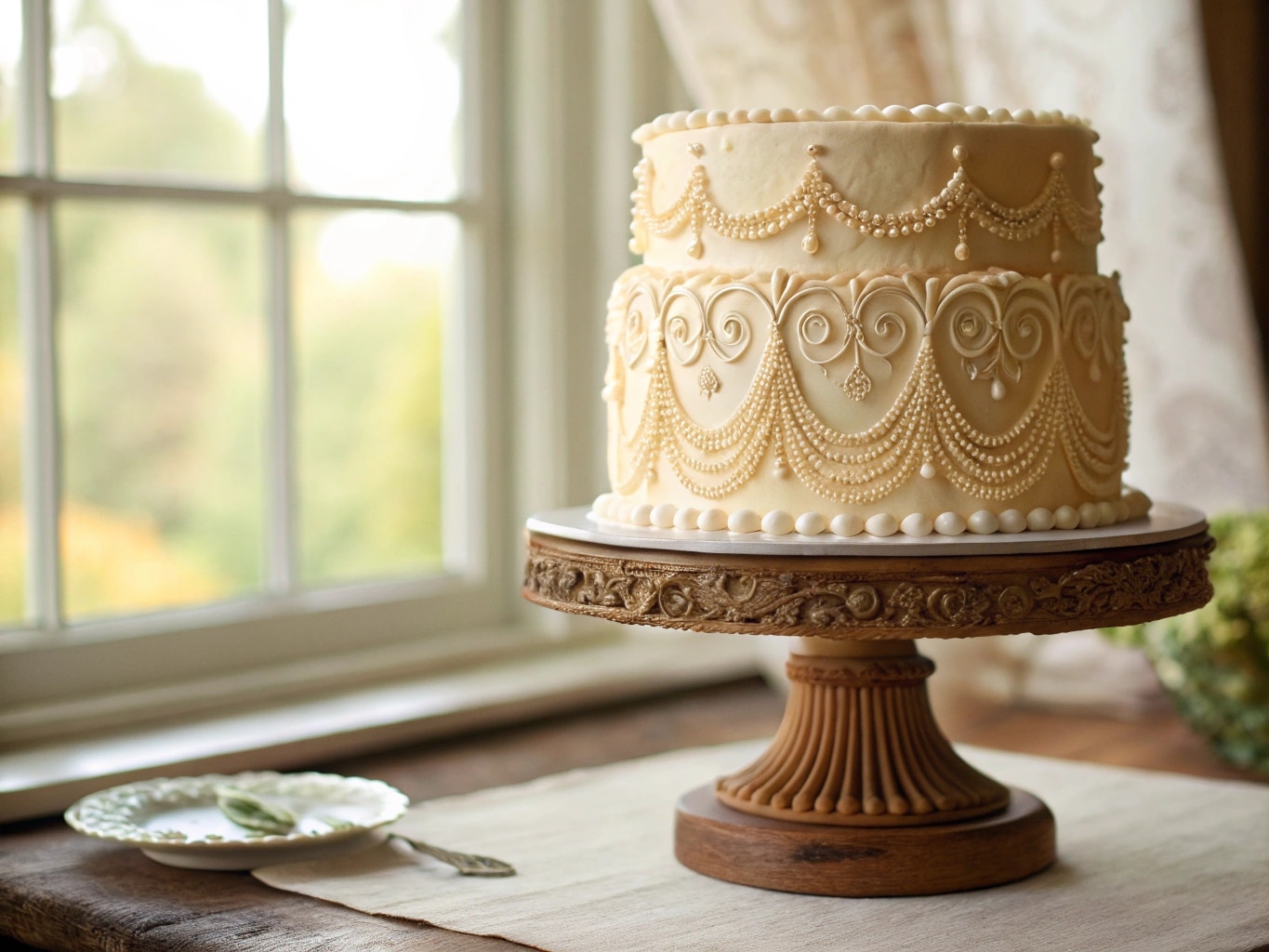Lambeth cake is back—and it’s not just a nostalgic nod to vintage cake artistry, it’s a full-blown statement of flavor and flair. In this article, I’m bringing you right into my kitchen to explore the timeless beauty and intricate piping that make Lambeth cakes so breathtaking. Whether you’re baking one for the first time or rediscovering an old-school favorite, I’ll guide you through the story, the techniques, and a trusted recipe. We’ll cover essential tools, step-by-step frosting tips, and how to give this historical showstopper a delicious modern twist—without losing its rich, decorative soul.
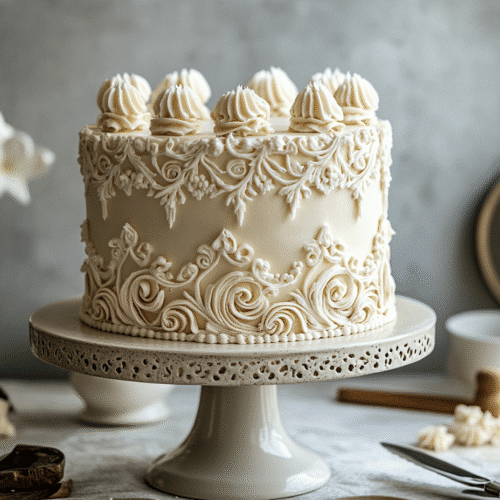
Lambeth Cake
Equipment
Ingredients
- Cake Base:
- 2 cups all-purpose flour
- 1 ½ cups granulated sugar
- ¾ cup unsweetened cocoa powder
- 1 tsp baking soda
- 1 tsp salt
- 2 large eggs
- 1 cup buttermilk
- ½ cup vegetable oil
- 1 tsp vanilla extract
- 1 cup hot water
- Royal Icing:
- 4 cups powdered sugar
- 3 tbsp meringue powder
- 6 tbsp warm water plus more if needed
- Gel food coloring optional
Instructions
- Preheat oven to 350°F (175°C). Grease and flour two 8-inch round cake pans.
- In a large bowl, whisk together flour, sugar, cocoa, baking soda, and salt.
- Add eggs, buttermilk, oil, and vanilla extract. Mix until smooth.
- Slowly stir in hot water. The batter will be thin.
- Divide evenly into prepared pans and bake for 30–35 minutes, or until a toothpick inserted comes out clean.
- Cool completely on wire racks. Level the cakes if needed.
- Prepare royal icing: beat powdered sugar, meringue powder, and warm water on high speed until stiff peaks form (about 7–10 minutes).
- Stack and fill the cakes if desired.
- Pipe a base border using royal icing. Let dry completely.
- Add scrolls, swags, and Lambeth-style decorations in layers, allowing each to dry before adding the next.
- Tint royal icing with gel coloring if using.
Notes
Nutrition
Table of Contents
A Sweet Memory in Frosting: My Lambeth Cake Obsession
Why I Fell for Lambeth Cake
It started with a rainy Sunday and a box of my grandmother’s cake decorating tips. You know the kind—tarnished metal, a little rust at the seams, and stories baked right into the steel. I was flipping through her old recipe book, the pages stained with cocoa and butter, when I spotted a grainy photo of a Lambeth cake. It was layered high, covered in impossibly detailed swirls, garlands, and scrolls that almost looked too perfect to be real. I was hooked.
To me, Lambeth cake isn’t just about aesthetics. It’s about that slow, satisfying rhythm of piping royal icing, the patience it demands, and the reward of creating something truly majestic. I remember my first attempt—a lopsided butter cake smothered in shaky swags. But just like my first chocolate cake in the toaster oven, it had heart. And I kept going.
What Makes a Lambeth Cake Different?
Lambeth cake is named after the Lambeth Method, a traditional English piping technique dating back to the early 20th century. Think layered borders, overlapping scrolls, and intricate drop strings—all done in firm royal icing. This isn’t your average buttercream affair. It’s cake decoration as architecture, and once you’ve mastered the basics, it feels like painting in sugar.
If you love classic design and vintage flair, the Lambeth cake is your canvas. It’s also a hit on social feeds right now, thanks to its ornate style and nostalgic charm. From wedding tiers to retro birthday cakes, its bold, maximalist look is totally back in vogue.
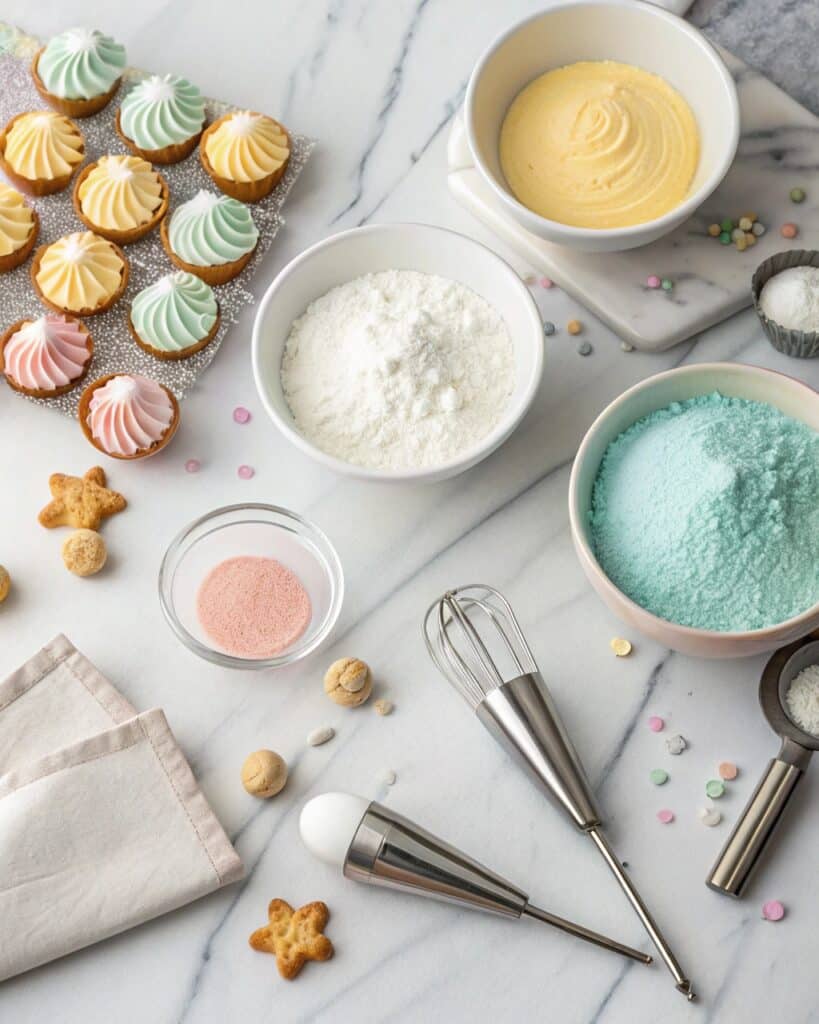
Just like my first chocolate cake, or this yellow cake with chocolate buttercream, it’s the imperfections that make it real
Mastering the Lambeth Method
Tools You Need for Lambeth Cake Success
Before you pipe your first bead border, gather the right tools. Lambeth cake relies on precision, and you’ll want a sturdy foundation. Start with a turntable to keep your hands steady and your lines even. A set of metal piping tips—especially open stars and petal tips—are your best friends here. Pair those with quality piping bags, couplers, and a small offset spatula for smoothing. And don’t forget the icing comb.
Use a dense, stackable cake base like chocolate pound or sponge—it holds up under layers of royal icing. For structure tips, my Chocolate Buttermilk Cake post has a batter that won’t let you down.
Royal icing is non-negotiable. It dries firm and holds its shape, unlike buttercream. Whip it until you get stiff peaks, then tint it with gel food coloring for pastel perfection. Make sure to cover unused icing with a damp towel to avoid crusting.
Layering and Piping Like a Pro
Lambeth design is all about layers. Begin by piping a base border—like shells or beads—then let it dry. Layer over that with scrolls, C-curves, and swooping drop strings. Use your offset spatula to nudge and lift where needed. The rhythm is slow, deliberate, and oddly therapeutic.
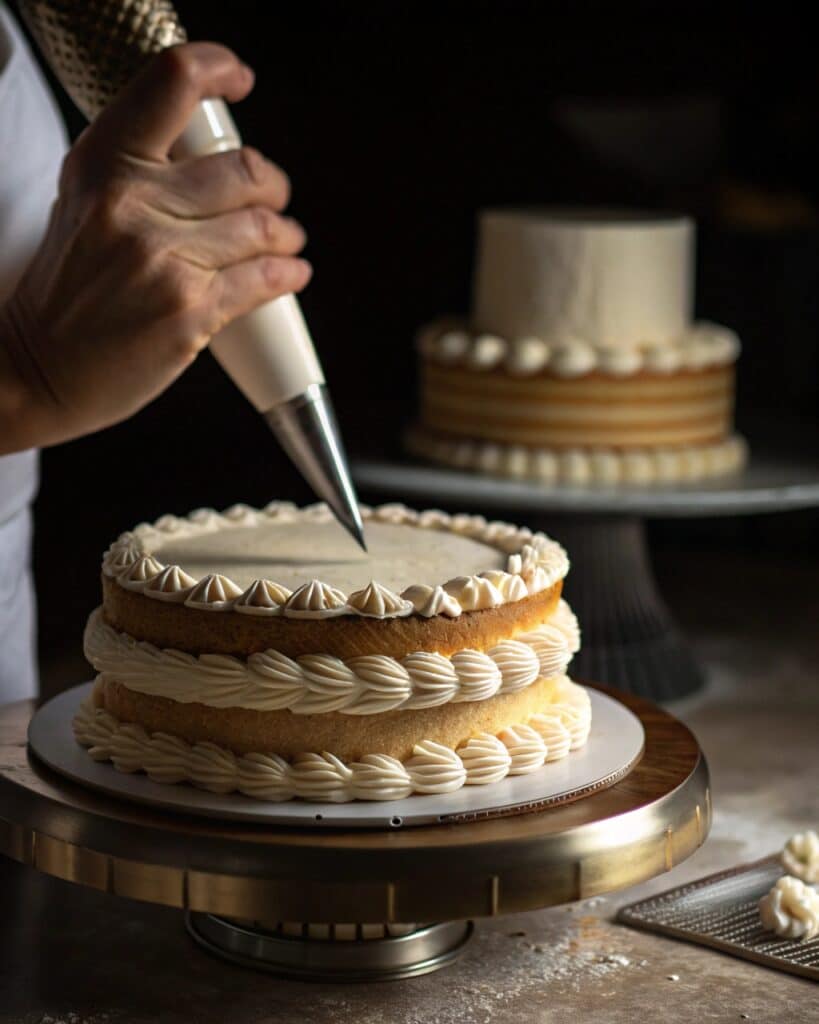
Practice on parchment first if you’re new, then move to the cake. Consistency in pressure is key. Mess up? Let it dry, chip it off, and try again. That’s part of the magic—it’s a forgiving art if you’re patient.
Want a darker twist? Add a touch of espresso like I do in this espresso-glazed chocolate cake.
Flavor That Matches the Flair
The Best Cake Flavors for Lambeth Decorating
While Lambeth cakes are showstoppers visually, flavor shouldn’t take a back seat. The base needs to be firm enough to support the weight of royal icing, but moist and rich enough to make guests go back for seconds. I love using a sturdy chocolate pound cake or a spiced vanilla layer with a hint of almond extract. These pair beautifully with the sugary crispness of royal icing.
Modern Twists on Classic Lambeth Cakes
You don’t have to stick to pastels and traditional swags. Today’s Lambeth cake revival embraces bold color palettes, ombre layers, and even edible gold leaf between piped tiers. You can modernize by pairing deep chocolate layers with blackberry jam filling or infusing your icing with lavender extract for a floral spin.
Another fun update? Add texture with crushed nuts between layers or switch your cake’s shape from classic round to square tiers or even heart-shaped—especially popular for retro-inspired weddings.
If you’re looking for a plant-based option, this vegan red velvet cake still holds structure well enough for piping
Combining flavor and form is what makes Lambeth cake more than a pretty face. It’s a fully immersive dessert—rich in style and just as rich in taste.
Serving & Storing Your Lambeth Cake
How to Serve a Lambeth Cake Without Breaking the Art
Cutting into a Lambeth cake feels like slicing into a sculpture—but it doesn’t have to be nerve-wracking. Use a hot, thin knife (dip in warm water, then dry) to glide through royal icing without cracking it. I usually score the top gently to guide my cuts, then slice with confidence. Serve thin slices—Lambeth cake is rich in both frosting and flavor.
If you want the cake to be the centerpiece before dessert, pipe it a day ahead and keep it covered in a cake box in a cool room. I’ve used this technique for parties, and it always keeps the structure—and wow factor—intact.
Lambeth piping isn’t just for round cakes—I’ve even used it to decorate a vegan red velvet loaf cake with elegant detail
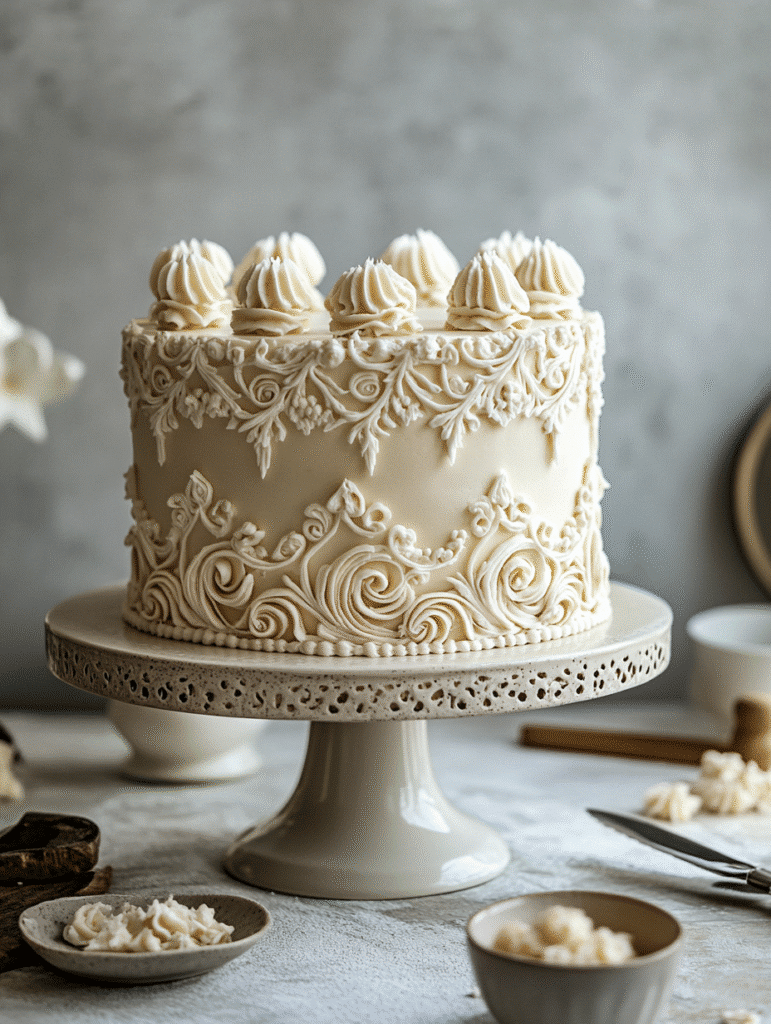
Storage Tips to Keep It Stunning
Because of the royal icing, Lambeth cakes don’t belong in the fridge—it causes condensation, which ruins the hard-set designs. Instead, keep it in a dry, room-temperature environment, protected from direct light. If you’ve used perishable fillings (like whipped cream or fresh berries), pipe the outer design separately and assemble right before serving.
Leftovers? Wrap slices in wax paper and store them in an airtight container for up to 3 days. You can freeze cake portions without icing and re-decorate later too.
Conclusion
Lambeth cake is more than a throwback—it’s a celebration of detail, patience, and edible art. From grandma’s piping tips to modern flair, this cake connects generations through sugar and style. Whether you’re creating a dramatic tiered showpiece or a petite piped layer, Lambeth cakes prove that sometimes, more really is more. Let your hands do the piping—and your guests will do the swooning.
For more recipe follow us in Facebook page
FAQ: Lambeth Cake
What is Lambeth style cake?
Lambeth style cake is a vintage cake decorating method known for intricate piping, overlapping scrolls, and multi-layered borders made with stiff royal icing. The style originated in 1930s England and creates a high-drama, elegant look.
What was the most expensive cake in the world?
The world’s most expensive cake is valued at over $75 million, created by British designer Debbie Wingham. It featured edible diamonds and gold, showcasing the ultimate in luxury confections.
What is the trend in Lambeth cake?
Modern Lambeth cake trends include bold color palettes, quirky shapes like hearts and squares, and whimsical touches like cherries, glitter, or metallic accents. It’s a favorite for retro weddings and fashion-forward celebrations.
What is Lambeth style buttercream?
While traditionally done in royal icing, some modern bakers replicate the Lambeth style using stiff American buttercream. It’s less crisp but easier to work with, especially for home decorators who prefer the taste.

